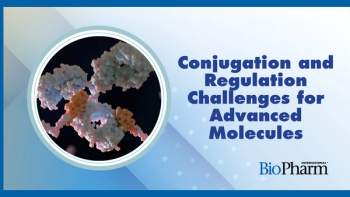
- BioPharm International-04-01-2021
- Volume 34
- Issue 4
Taking a Breath: Advances in Inhaled Biologics
The inhaled route of administration for biologics is experiencing renewed interest, particularly in light of the COVID-19 pandemic.
The global appetite for biological therapeutics is growing, with estimates for the market to surpass US $4 billion by 2025 (1). For the most part, biologics are delivered intravenously as a result of the complex and large nature of biomolecules, poor permeability through the intestinal epithelium, and susceptibility to enzymatic degradation in the gastrointestinal tract (2).
However, injections are considered to be painful and inconvenient by many patients, particularly in cases where chronic conditions are being treated. Therefore, alternative routes of delivery, such as inhalation, for biologics are being investigated to improve systemic drug absorption and overcome the treatment burden associated with intravenous administration (3).
To learn more about inhaled administration of biologics—the advantages of this delivery route as well as its limitations and challenges—BioPharm International spoke with Catherine Oliver, specialist—Pharmaceutical Development, Vectura.
Obvious advantages
BioPharm: Why is inhaled administration of biologics attractive when compared with other delivery routes?
Oliver (Vectura): Traditionally, biologics are given through injections or infusions due to poor oral bioavailability. However, up to one in 10 of the population are anxious about injections. Administration of infusions requires skilled personnel to prepare and administer.
Drug delivery via inhalation offers obvious advantages for treating diseases of the lung. For respiratory therapies, it allows the drug to reach the site of action directly. Inhalation can also be a viable route for the delivery of systemically acting drugs, not least because it gives a fast onset of action through high systemic bioavailability.
There is renewed interest in inhalation as a route for administration of biologics, both systemic and locally acting. The COVID-19 pandemic has highlighted the difficulties associated with lung damage, and may well prove to be a catalyst for greater efforts for innovation in this field.
Development obstacles
BioPharm: What are the main obstacles to a successful development program of an inhaled biologic?
Oliver (Vectura): There are two important aspects to consider when developing an inhaled biologic: making particles/droplets that are sufficiently small to be inhaled; and the aerosolization of dry powders produced by spray-drying, lyophilization, or nebulization of solutions for inhalation. Both have the potential to affect product quality through decreased activity or protein aggregation. Biologics tend to be complex large molecules and, as such, have more potential sites for degradation. It is essential that the formulation and packaging system are optimized with the intended delivery system in mind. Therefore, critical quality attributes (CQAs) for the drug product are carefully defined and assessed.
Lastly, patient factors must be considered. Any novel inhaler must have noticeable beneficial impact on therapy effectiveness, compliance and patient lifestyle and be able to demonstrate that it is just as effective at delivering the required dose as other forms of administration.
Greater understanding
BioPharm: Have there been any technological advances that have helped developers overcome the hurdles associated with inhaled biologic development?
Oliver (Vectura): However carefully a biologic has been designed and developed, there is still no guarantee that a successful inhaled formulation will be possible.
A greater understanding of factors affecting biologic stability has resulted in improved drying techniques to produce inhalable dry powders. For example, for biologics that are unstable as aqueous solutions, understanding both the optimal residual moisture content and excipient characteristics can inform formulation for drying processes to ensure a stable dry powder. This can enable room temperature storage and negate the need for cold chain storage.
It has been known for some time that nanoparticles/nanobodies are effective at overcoming pulmonary clearance by mucocilary escalator or macrophage capture. This technology has never been more topical due to clinical trials of COVID vaccines, containing mRNA [messenger RNA] encapsulated in lipid nanoparticles, being administered by nebulization.
Whilst there have been successful biologic dry powder inhalers (DPIs) delivery of a liquid formulation using some form of nebulizer is more likely to be considered. The innovator now has a choice of nebulizer types for precise delivery to specific areas
of the lung, such as the use of smart nebulizers to deliver anti-infective treatments deep into the lungs. New DPI and nebulizer inhaler technologies are being developed to facilitate proper inhalation technique by providing feedback during drug administration to the patient or the health-care professional during inhalation.
Excipient limitations
BioPharm: Do you believe that the limited number of ‘approved’ excipients for use in inhaled biologics poses a significant challenge to development?
Oliver (Vectura): This is certainly a challenge. The number of excipients for parenteral biologics is about 300; however, less than 20% of these are permitted for inhalation. Historically, the majority of excipients have been approved to support formulation for oral drug delivery. Increased scientific understanding is driving targeting of drugs either to specific parts of the lungs or sites within the body. Both biologics and other new inhaled medicines may need new or innovative technologies to succeed.
There may be times when gaining approval for a novel excipient is necessary because a novel-product-enabling approach is being taken. The need for new excipients will have to be assessed on a case-by-case basis, such as where the stability of the formulation is sub-optimal, or its flow properties cannot be made acceptable with existing substances.
One area where an excipient could be advantageous is in increasing the residual time of the drug in the lungs, rather than it being absorbed and transported. This is something of a holy grail for developers, but if the aim of a novel inhaled formulation is systemic delivery, the opposite is required: very rapid uptake. The potential for a novel excipient in this area here, too, is large.
Reformulation option
BioPharm: Can reformulation provide a convenient route for developers to achieve an inhaled formulation of a biologic?
Oliver (Vectura): Inhalation may be a potential route for a successful reformulation of a marketed biologic, particularly if faster onset of action might be beneficial. However, it does not always follow that an active ingredient that is stable in a liquid formulation for intravenous delivery can demonstrate stability when delivered by inhalation.
It is possible that an existing formulation can be nebulized; however, it is more likely that it will require reformulation. The indication will impact the choice of the delivery method/device to be used. This will then dictate the presentation and formulation choices. Each presents a novel challenge: stability as a dry powder formulation in a moisture-free environment versus sensitivity of liquid formulations, to shear forces during nebulization. This presents an opportunity to simplify the existing formulation, for example, to remove excipients, such as buffer salts or non-reducing sugars used to stabilize spray-dried/lyophilized proteins.
Creating a suitable formulation for the chosen delivery system will require an integrated approach between analytical scientists, process experts, and device engineers to be successful.
Regulatory challenges
BioPharm: Are there any regulatory challenges that developers should consider when approaching inhaled biologics?
Oliver (Vectura): There are significant regulatory challenges in this area, and with so few approved inhaled biologics published, FDA guidance is limited. The FDA guidance for metered dose inhalers and DPIs used for small-molecule drugs was updated and a new draft issued in April 2018, while the guidance on ‘nasal spray and inhalation solution, suspension, and spray drug products’ was finalized in July 2002 (4,5).
The inhalation field continues to progress significantly. Industry groups, such as The International Pharmaceutical Aerosol Consortium on Regulation & Science and European Pharmaceutical Aerosol Group, which Vectura supports, are working to establish best practice for innovators in the development and registration of inhaled biologics.
References
1. BCC Research, “Biologic Therapeutic Drugs: Technologies and Global Markets,” Market Research Report (April 2021).
2. W. Liang, et al., Pharmaceutics, 12 (11) 1025 (2020).
3. J.O. Morales, et al., AAPS J., 19 (May) 652–668 (2017) [and references therein].
4. FDA, Metered Dose Inhaler (MDI) and Dry Powder Inhaler (DPI) Drug Products—Quality Considerations, Guidance for Industry, Draft (CBER, April 2018).
5. FDA, Nasal Spray and Inhalation Solution, Suspension, and Spray Drug Products—Chemistry, Manufacturing, and Controls Documentation, Guidance for Industry, (CBER, July 2002).
About the Author
Felicity Thomas is the European editor for BioPharm International.
Article Details
BioPharm International
Vol. 34, No. 4
April 2021
Pages: 18–20, 46
Citation
When referring to this article, please cite it as F. Thomas, “Taking a Breath: Advances in Inhaled Biologics,” BioPharm International 34 (4) 2021.
Articles in this issue
almost 5 years ago
Maximum Output Starts with Optimized Upstream Processingalmost 5 years ago
Single-Use Bags Help Maintain Aseptic Ingredient Transfer to Bioreactorsalmost 5 years ago
Fluid Handling Systems are Seeing Benefit from Single-Use Technologiesalmost 5 years ago
Beyond Lyophilizationalmost 5 years ago
Stability Testing of Protein Therapeutics Using DLSalmost 5 years ago
Supply Chain Challenges Creating Hurdles to COVID-19 Vaccine Productionalmost 5 years ago
Pressure Mounts for FDA to Ramp Up Drug Inspectionsalmost 5 years ago
Avoiding Unforced Errors in the Bio/Pharma IndustryNewsletter
Stay at the forefront of biopharmaceutical innovation—subscribe to BioPharm International for expert insights on drug development, manufacturing, compliance, and more.




